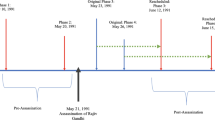Abstract
Much work on the apparent ineffectiveness on incumbent spending in congressional elections has hypothesized that the productivity of incumbent spending is low because incumbents operate on the “flat part” of their election returns function. Differences in campaign spending associated with state campaign finance laws allows for a test of this hypothesis because restrictions on campaign contributions tend to reduce campaign spending. Exploiting cross-state variation in campaign finance laws, this study tests whether campaign expenditures by state House candidates are more productive when candidates are subject to contribution limits. The results show that campaign expenditures by incumbents and challengers are more productive when candidates run in states with campaign contribution limits, as opposed to in states without limits. In states with contribution limits, incumbent spending and challenger spending are equally productive, and spending by both candidates is quantitatively important in increasing their vote shares.
Similar content being viewed by others
References
Abramowitz, A.I. (1991). Incumbency, campaign spending, and the decline of competition in U.S. House elections. Journal of Politics, 53, 34–56.
Ansolabehere, S., & Gerber, A. (1994). The mismeasure of campaign spending: evidence from the 1990 U.S. House elections. Journal of Politics, 56(4), 1106–1118.
Ashworth, S. (2002). Campaign finance and voter welfare with entrenched incumbents. mimeo, Harvard University.
Berry, W.D., Berkman, M.B., & Schneiderman, S. (2000). Legislative professionalism and incumbent reelection: the development of institutional boundaries. American Political Science Review, 94(4), 859–874.
Coate, S. Pareto-improving campaign finance policy. American Economic Review, 94(3), 628–655.
Coates, D. (1998). Additional incumbent spending really can harm (at least some) incumbents: an analysis of vote share maximization. Public Choice, 95(2), 63–87.
Epstein, D., & Zemsky, P. (1995). Money talks: deterring quality challengers in congressional elections. American Political Science Review, 89, 295–308.
Feigenbaum, E.D., & Palmer, J.A. (1980–2000). Campaign Finance Law, Federal Election Commission, bi-annual issues.
Fiorina, M. (1994). Divided government in the AMERICAN STATES: A BYPRODUCT OF LEGISLATIVE PROFESSIONALISM. American Journal of Political Science, 88, 304–316.
Gerber, A. (1998). Estimating the effect of campaign spending on senate election outcomes using instrumental variables. American Political Science Review, 92, 401–411.
Gierzynski, A., & Breaux, D. (1991). Money and votes in state legislative election. Legislative Studies Quarterly, 16, 203–217.
Green, D., & Krasno, J. (1988). Salvation of the spendthrift incumbent: reestimating the effects of campaign spending in House elections. American Journal of Political Science, 32, 884–907.
Greene, W. (2000). Econometric analysis. Prentice Hall. 4th Edition.
Grier, K.B. (1989). Campaign spending and senate elections, 1978–1984. Public Choice, 63(3), 201–220.
Gross, D.A., Goidel, R.K., & Shields, T.G. (2002). State campaign finance regulations and electoral competition. American Politics Research, 30(2), 143–165.
Herrnson, P. (2000) Congressional elections: campaigning at home and in Washington. Washington, D.C.: CQ Press, 3rd ed.
Hogan, R. (2000). The costs of representation in state legislatures: explaining variations in campaign spending. Social Science Quarterly.
Houser, D. & Stratmann, T. (2006) Selling favors in the lab: Experiments on campaign finance reform. Working paper. George Mason University.
Jacobson, G.C. (1978). The effects of campaign spending on congressional elections. American Political Science Review, 72, 469–491.
Jacobson, G.C. (1987). The marginals never vanished: incumbency and competition in elections to the U.S. House of Representatives, 1952–1982. American Journal of Political Science, 31, 126–141.
Jacobson, G.C. (1997). The Politics of Congressional Elections, 4th Edition, New York: Longman.
Koenker, R., & Basset, G. (1978). Regression quantiles. Econometrica, 46, 107–112.
Levitt, S. (1994). Using repeat challengers to estimate the effect of campaign spending on election outcomes in the U.S. House. Journal of Political Economy, 103, 777–798.
Lowry, R.C., Alt, J.E., & Ferree, K.E. (1999). Fiscal policy outcomes and electoral accountability in the AMERICAN STATES. American Political Science Review, 92, 759–774.
Malbin, M.J., & Gais, T.L. (1998). The day after reform: sobering campaign finance lessons from the American states, Rockefeller Institute Press.
Milyo, J. (1997). The economics of campaign finance: FECA and the Puzzle of the Not Very Greedy Grandfathers. Public Choice, 93, 245–270.
Milyo, J., & Groseclose, T. (1999). The electoral effects of incumbent wealth. Journal of Law and Economics, 42(2), 699–722.
Moncrief, G.F. (1999). Recruitment and retention in U.S. legislatures. Legislative Studies Quarterly, 24, 173–208.
Mueller, D. (2003). Public Choice III, Cambridge University Press.
Palda F., & Palda, K. (1998). The impact of campaign expenditures on political competition in the French legislative elections of 1993. Public Choice, 94, 157–174.
Prat, A. (2002). Campaign spending with office-seeking politicians, rational voters, and multiple lobbies. Journal of Economic Theory, 103(1), 162–189.
SQAD Media Market Guide, Spring 1996, 1998, and 2000.
Stratmann, T. (1991). What do campaign contributions buy? Deciphering causal effects of money and votes. Southern Economic Journal, 57(3), 606–620.
Stratmann, T. (1995). Campaign contributions and congressional voting: Does the timing of contributions matter? Review of Economics and Statistics, 77(1), 127–136.
Stratmann, T. (2002). Can special interests buy congressional votes? Evidence from financial services legislation. Journal of Law and Economics, 45(2), 345–364.
Statmann, T. & Aparicio-Castillo, F.J. (2006) Competition policy for elections: Do campaign contribution limits matter? Public Choice, 127(1–2), 177–206.
Wald, A. (1940). The fitting of straight lines if both variables are subject to error. Annals of Mathematical Statistics, 11, 284–300.
Author information
Authors and Affiliations
Corresponding author
Rights and permissions
About this article
Cite this article
Stratmann, T. Contribution limits and the effectiveness of campaign spending. Public Choice 129, 461–474 (2006). https://doi.org/10.1007/s11127-006-9066-4
Received:
Revised:
Accepted:
Published:
Issue Date:
DOI: https://doi.org/10.1007/s11127-006-9066-4




